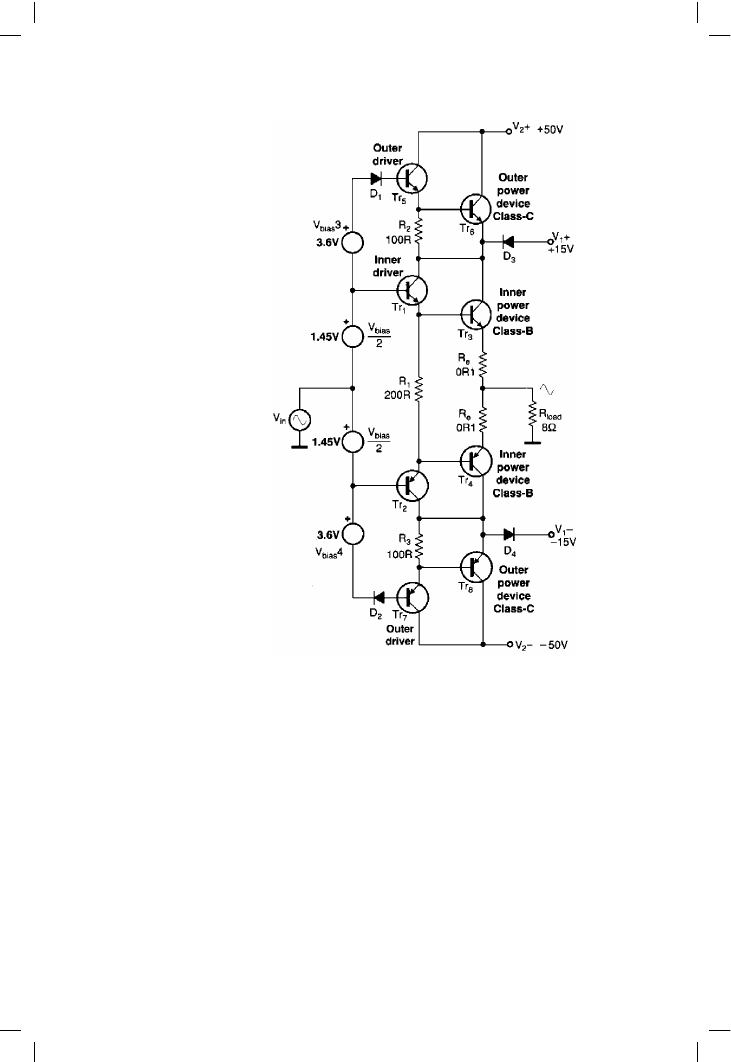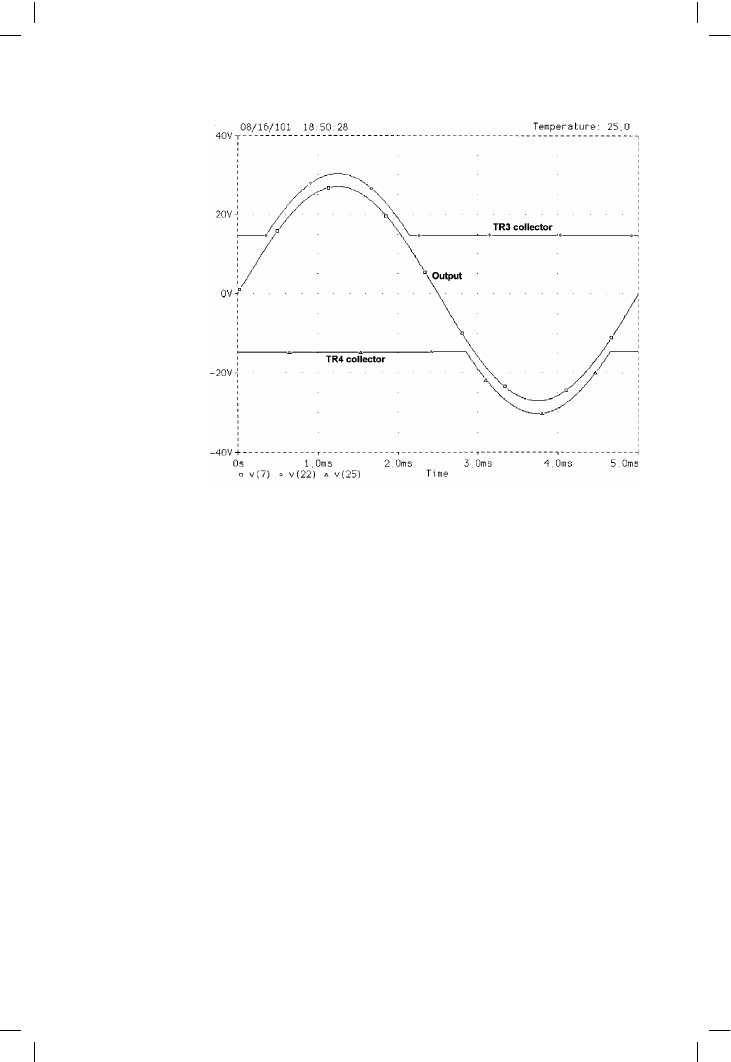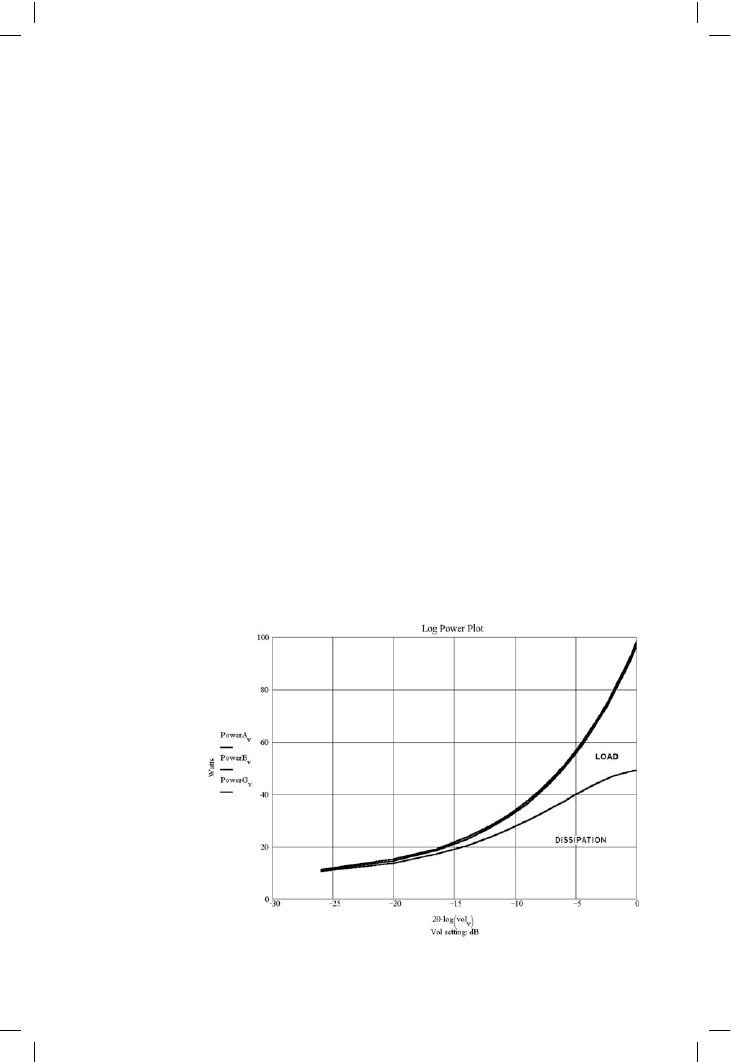ВУЗ: Казахская Национальная Академия Искусств им. Т. Жургенова
Категория: Учебное пособие
Дисциплина: Не указана
Добавлен: 03.02.2019
Просмотров: 17397
Скачиваний: 18

10
Class-G power amplifiers
Most types of audio power amplifier are less efficient than Class-B; for
example, Class-AB is markedly less efficient at the low end of its power
capability, while it is clear that Class-A wastes virtually all the energy put
into it. Building amplifiers with higher efficiency is more difficult. Class-D,
using ultrasonic pulse-width modulation, promises high efficiency and
sometimes even delivers it, but it is undeniably a difficult technology. The
practical efficiency of Class-D rests on details of circuit design and device
characteristics. The apparently unavoidable LC output filter – second order
at least – can only give a flat response into one load impedance, and its
magnetics are neither cheap nor easy to design. There are likely to be some
daunting EMC difficulties with emissions. Class-D is not an attractive
proposition for high-quality domestic amplifiers that must work with
separate speakers of unknown impedance characteristics.
There is, however, the Class-G method. Power is drawn from either high- or
low-voltage rails as the signal level demands. This technology has taken a
long time to come to fruition, but is now used in very-high-power
amplifiers for large PA systems, where the power savings are important, and
is also making its presence felt in home theatre sytems; if you have seven
or eight power amplifiers instead of two their losses are rather more
significant. Class-G is firmly established in powered subwoofers, and even
in ADSL telephone-line drivers. It is a technology whose time has come.
The principles of Class-G
Music has a large peak-to-mean level ratio. For most of the time the power
output is a long way below the peak levels, and this makes possible the
improved efficiency of Class-G. Even rudimentary statistics for this ratio for
various genres of music are surprisingly hard to find, but it is widely
accepted that the range between 10 dB for compressed rock, and 30 dB for
classical material, covers most circumstances.
290

Class-G power amplifiers
If a signal spends most of its time at low power, then while this is true a low-
power amplifier will be much more efficient. For most of the time lower
output levels are supplied from the lowest-voltage rails, with a low voltage
drop between rail and output, and correspondingly low dissipation. The
most popular Class-G configurations have two or three pairs of supply rails,
two being usual for hi-fi, while three is more common in high-power PA
amplifiers.
When the relatively rare high-power peaks do occur they must be handled
by some mechanism that can draw high power, causing high internal
dissipation, but which only does so for brief periods. These infrequent
peaks above the transition level are supplied from the high-voltage pair of
rails. Clearly the switching between rails is the heart of the matter, and
anyone who has ever done any circuit design will immediately start
thinking about how easy or otherwise it will be to make this happen cleanly
with a 20 kHz signal.
There are two main ways to arrange the dual-rail system: series and parallel
(i.e. shunt). This chapter deals only with the series configuration, as it seems
to have had the greatest application to hi-fi. The parallel version is more
often used in high-power PA amplifiers.
Introducing series class-G
A series configuration Class-G output stage using two rail voltages is shown
in Figure 10.1 The so-called inner devices are those that work in Class-B;
those that perform the rail-switching on signal peaks are called the outer
devices – by me, anyway. In this design study the EF type of output stage is
chosen because of its greater robustness against local HF instability, though
the CFP configuration could be used instead for inner, outer, or both sets of
output devices, given suitable care. For maximum power efficiency the
inner stage normally runs in Class-B, though there is absolutely no reason
why it could not be run in Class-AB or even Class-A; there will be more
discussion of these intriguing possibilities later. If the inner power devices
are in Class-B, and the outer ones conduct for much less than 50% of a
cycle, being effectively in Class-C, then according to the classification
scheme I proposed
[1]
, this should be denoted Class B + C. The plus sign
indicates the series rather than shunt connection of the outer and inner
power devices. This basic configuration was developed by Hitachi to
reduce amplifier heat dissipation
[2,3]
. Musical signals spend most of their
time at low levels, having a high peak/mean ratio, and power dissipation is
greatly reduced by drawing from the lower ±V1 supply rails at these
times.
The inner stage TR3, 4 operates in normal Class-B. TR1, 2 are the usual
drivers and R1 is their shared emitter resistor. The usual temperature
compensated Vbias generator is required, shown here theoretically split in
291

Audio Power Amplifier Design Handbook
half to maintain circuit symmetry when the stage is SPICE simulated; since
the inner power devices work in Class-B it is their temperature which must
be tracked to maintain quiescent conditions. Power from the lower supply
is drawn through D3 and D4, often called the commutating diodes, to
emphasise their rail-switching action. The word ‘commutation’ avoids
confusion with the usual Class-B crossover at zero volts. I have called the
level at which rail-switching occurs the transition level.
When a positive-going instantaneous signal exceeds low rail +V1, D1
conducts, TR5 and TR6 turn on and D3 turns off, so the entire output
current is now taken from the high-voltage +V2 rail, with the voltage drop
and hence power dissipation shared between TR4 and TR6. Negative-going
signals are handled in exactly the same way. Figure 10.2 shows how the
collector voltages of the inner power devices retreat away from the output
rail as it approaches the lower supply level.
292
Figure 10.1
A series Class-G output
stage, alternatively
Class B + C. Voltages
and component values
are typical. The inner
stage is Class-B EF.
Biasing by my method

Class-G power amplifiers
Class-G is commonly said to have worse linearity than Class-B, the blame
usually being loaded onto the diodes and problems with their commuta-
tion. As usual, received wisdom is only half of the story, if that, and there
are other linearity problems that are not due to sluggish diodes, as will be
revealed shortly. It is inherent in the Class-G principle that if switching
glitches do occur they only happen at moderate power or above, and are
well displaced away from the critical crossover region where the amplifier
spends most of its time. A Class-G amplifier has a low-power region of true
Class-B linearity, just as a Class-AB amplifier has a low-power region of true
Class-A performance.
Efficiency of Class-G
The standard mathematical derivation of Class-B efficiency with sinewave
drive uses straightforward integration over a half-cycle to calculate internal
dissipation against voltage fraction, i.e. the fraction of possible output
voltage swing. As is well known, in Class-B the maximum heat dissipation
is about 40% of maximum output power, at an output voltage fraction of
63%, which also delivers 40% of the maximum output power to the
load.
The mathematics is simple because the waveforms do not vary in shape
with output level. Every possible idealisation is assumed, such as zero
quiescent current, no emitter resistors, no Vce(sat) losses and so on. In
293
Figure 10.2
The output of a Class-
G stage and the
voltages on the
collectors of the inner
output devices

Audio Power Amplifier Design Handbook
Class-G, on the other hand, the waveforms are a strong function of output
level, requiring variable limits of integration and so on, and it all gets very
unwieldy.
The SPICE simulation method described by Self
[4]
is much simpler, if
somewhat laborious, and can use any input waveform, yielding a Power
Partition Diagram, (PPD) which shows how the power drawn from the
supply is distributed between output device dissipation and useful power in
the load.
No one disputes that sinewaves are poor simulations of music for this
purpose, and their main advantage is that they allow direct comparison
with the purely mathematical approach. However, since the whole point of
Class-G is power saving, and the waveform used has a strong effect on the
results, I have concentrated here on the PPD of an amplifier with real
musical signals, or at any rate, their statistical representation. The triangular
Probability Distribution Function (PDF) approach is described in Self
[5]
.
Figure 10.3 shows the triangular PDF PPD for conventional Class-B EF, while
Figure 10.4 is that for Class-G with ±V2 = 50 V and ±V1 = 15 V, i.e. with the
ratio of V1/V2 set to 30%. The PPD plots power dissipated in all four output
devices, the load, and the total drawn from the supply rails. It shows how the
input power is partitioned between the load and the output devices. The total
sums to slightly less than the input power, the remainder being accounted for
as usual by losses in the drivers and Re’s. Note that in Class-G power
dissipation is shared, though not very equally, between the inner and outer
devices, and this helps with efficient utilisation of the silicon.
294
Figure 10.3
Power partition
diagram for a
conventional Class-B
amplifier handling a
typical music signal
with a triangular
Probability Density
Function. X-axis is
volume